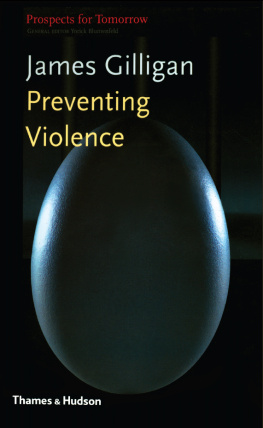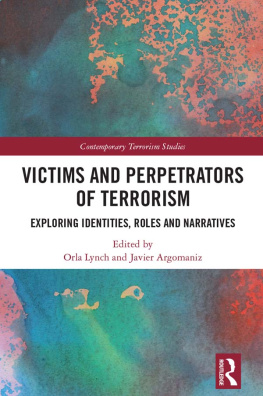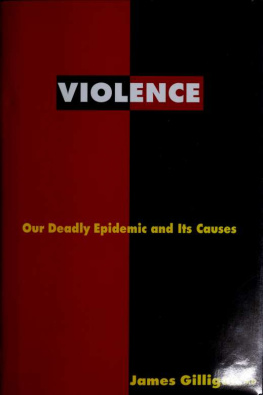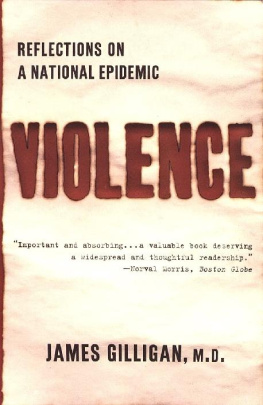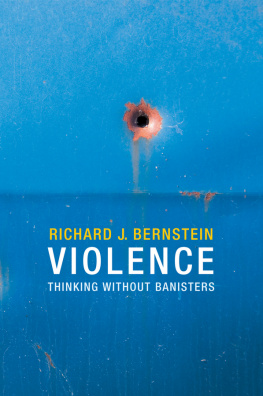Gilligan - Preventing Violence
Here you can read online Gilligan - Preventing Violence full text of the book (entire story) in english for free. Download pdf and epub, get meaning, cover and reviews about this ebook. City: London, year: 2001, publisher: Thames & Hudson, genre: Politics. Description of the work, (preface) as well as reviews are available. Best literature library LitArk.com created for fans of good reading and offers a wide selection of genres:
Romance novel
Science fiction
Adventure
Detective
Science
History
Home and family
Prose
Art
Politics
Computer
Non-fiction
Religion
Business
Children
Humor
Choose a favorite category and find really read worthwhile books. Enjoy immersion in the world of imagination, feel the emotions of the characters or learn something new for yourself, make an fascinating discovery.
Preventing Violence: summary, description and annotation
We offer to read an annotation, description, summary or preface (depends on what the author of the book "Preventing Violence" wrote himself). If you haven't found the necessary information about the book — write in the comments, we will try to find it.
Gilligan: author's other books
Who wrote Preventing Violence? Find out the surname, the name of the author of the book and a list of all author's works by series.
Preventing Violence — read online for free the complete book (whole text) full work
Below is the text of the book, divided by pages. System saving the place of the last page read, allows you to conveniently read the book "Preventing Violence" online for free, without having to search again every time where you left off. Put a bookmark, and you can go to the page where you finished reading at any time.
Font size:
Interval:
Bookmark:
Prospects for Tomorrow
Preventing Violence
Prospects for Tomorrow
James Gilligan

The only way to get kids not to hurt each other is to get kids not to want to hurt each other.
Russell Novotny, a recent high school graduate, commenting on the emphasis on metal detectors and security guards as the main response to a recent epidemic of mass murders in American high schools
(Adrian LeBlanc, The Outsiders, New York Times Magazine, August, 1999)
Using the cops to crack crime is like taking aspirin for a brain tumor.
Philip Marlowe, in Raymond Chandlers The Long Goodbye
Any copy of this book issued by the publisher as a paperback is sold subject to the condition that it shall not by way of trade or otherwise be lent, resold, hired out or otherwise circulated without the publishers prior consent in any form of binding or cover other than that in which it is published and without a similar condition including these words being imposed on a subsequent purchaser.
2001 James Gilligan
First published in paperback in the United States of America in 2001 by Thames & Hudson Inc., 500 Fifth Avenue, New York, New York 10110
Library of Congress Catalog Card Number 00-108865
eISBN 978-0-500-77056-6
All Rights Reserved. No part of this publication may be reproduced or transmitted in any form or by any means, electronic or mechanical, including photocopy, recording or any other information storage and retrieval system, without prior permission in writing from the publisher.
Printed and bound in Slovenia by Mladinska Knjiga
For the past four millennia, since the time of the first law-giversHammurabi and Moses, Drakon and Solon, Plato and Aristotle, Cicero and Justinianhumanity has been engaged in a great social experiment, testing the hypothesis that we could prevent violence, or at least diminish its scale and intensity, by labeling it evil and criminal; ordering people not to engage in it; and then, when they commit acts of violence anyway, retaliating with more violence of our own, which we call punishment and justice. Now, four thousand years is long enough to test any hypothesis, and the results of this experiment have been in for a long time: this means of attempting to prevent violence, which I will call the traditional moral and legal approach, far from solving the problem of violence, or even diminishing the threat it poses to our continued survival, has in fact been followed by a continued escalation of the frequency and intensity of violence, to the point that the century we have just survived has been the bloodiest in all human history, with more humans killing other humans than in all previous centuries combined. Worse yet, we have now achieved, through a deliberate effort, the technological ability to kill everyone on earth, thus becoming the first species in evolutionary history to be in danger of bringing about its own extinctionunless we can increase our ability to prevent violence far more effectively than we have for the past four thousand years.
Given that the approach used for the past four millennia has been such a total failureindeed, has been so counter-productive, resulting in more rather than less violencethe beginning of a new millennium would seem to be an auspicious moment to consider replacing that ancient strategy with a radically new and different one. That is why I welcomed the invitation to contribute to this series of books on the major challenges and opportunities, the major problems and most promising solutions, that we can anticipate during the coming millennium, and to bring to bear on the most important problem a perspective derived from the human sciences.
Many judges and legal scholars, and even some legislators, agree that there is a need to question many of the laws traditional assumptions and practices, and are working to bring the criminal justice system into the twenty-first century. For example, there are many experiments with attempts to replace retributive with restorative justice, and to develop new concepts such as therapeutic jurisprudence, alternative sentencing schemes, drug courts, and so on, as I will discuss at greater length in Chapter 7. On a larger scale, many national governments and even international bodies like the United Nations and the International Criminal Tribunal in The Hague are trying to discover, or invent, new bases for negotiating an end to collective violence in all its formsgenocide, war crimes, totalitarianism, racial discrimination, ethnic cleansing, and so on; for repairing the physical and psychological trauma those forms of violence leave in their wake; and for preventing new outbreaks of them, through truth and reconciliation commissions, selective amnesty policies, peacekeeping missions, abandonment of traditional notions of national sovereignty, and so on. They are engaging in these social and legal experiments in the only way that we have ever been able to develop successful new strategies for living togethernamely, slowly, painfully, controversially, by trial and error, and in an atmosphere of humility and open debate rather than of vengeance and self-righteousness.
In other words, the issue I am raising here is not a debate between law and psychiatry as much as a debate that is going on within the law itself, which to its credit has given it more attention than most psychiatrists have, with many judges, law schools, and schools of government and public policy welcoming contributions from several different disciplines. Many of the judges, attorneys, government officials, legislators, law enforcement professionals and prison administrators with whom I have worked over the past thirty years are clearly aware of the massive shortcomings and failures of our traditional ways of attempting to cope with the dangers to which the human propensity for violence exposes us all. The only question is: with what can we replace them? That is what I will try to outline in what follows.
In this short book, I will make no attempt to provide a comprehensive survey of the many specific community initiatives proposed for preventing violence. Excellent compendia and summaries are already available (e.g. Sherman, et al., Preventing Crime, 1997; Tonry and Farrington, Building a Safer Society, 1995; Tolan and Guerra, What Works in Reducing Adolescent Violence, 1998). They can also be found increasingly, on the internet: for example, on its website, http://www.colorado.edu/cspv/blueprints/index.html, the Center for the Study and Prevention of Violence at the University of Colorado, Boulder, has identified ten highly effective violence prevention programs, sufficient to provide a nucleus for a national violence prevention initiative, and seventeen promising programs. Nor have I attempted to write a how-to or cookbook approach, summarizing step-by-step recipes for putting together any one program.
I have two worries about much of what passes for violence prevention in the literature on this subject (apart from such thoughtful treatments as those referred to above). The first is that we are in danger of forgetting that when we talk about preventing violence, we are not talking about something that can be solved with gimmicks; we are not talking about techniques. We are talking about whether, and how, we and other human beings can learn to live with each other, and even to want to live with each otherand I mean live as opposed to die, for that is the only other choice where violence is concerned. But that is too profound a question to be answered by anything other than a radical rethinking of the most basic principles on which our social life is based. We are in danger of not seeing the forestor, more to the point, of not noticing that the forest as a whole is being destroyed as we talkif we get distracted by examining a thousand different little trees. As David Downes has written in
Next pageFont size:
Interval:
Bookmark:
Similar books «Preventing Violence»
Look at similar books to Preventing Violence. We have selected literature similar in name and meaning in the hope of providing readers with more options to find new, interesting, not yet read works.
Discussion, reviews of the book Preventing Violence and just readers' own opinions. Leave your comments, write what you think about the work, its meaning or the main characters. Specify what exactly you liked and what you didn't like, and why you think so.

